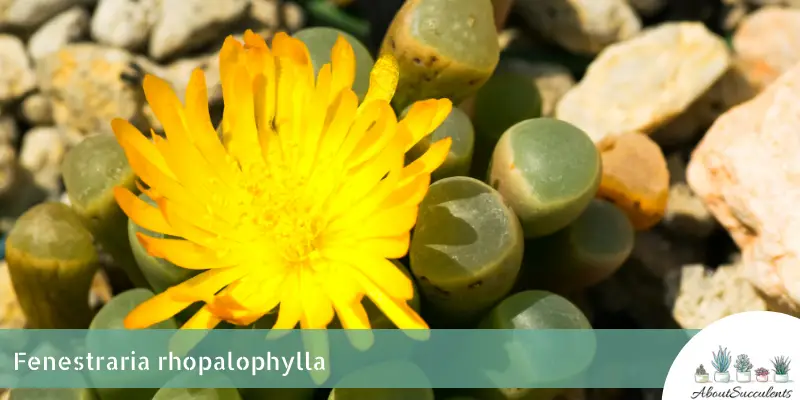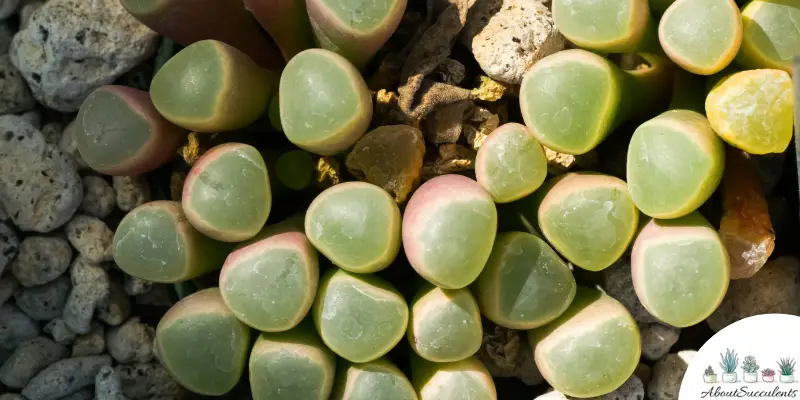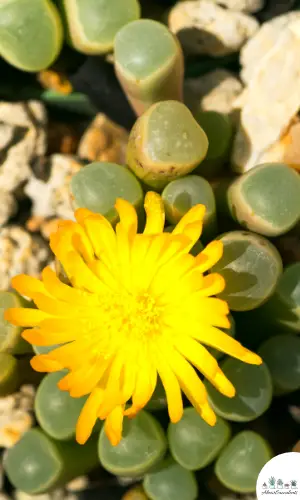
Fenestraria Rhopalophylla also known as ‘Baby Toes’ is a succulent herb that forms tightly packed columns of toe-like leaves.
The stems are very short and barely visible because they grow underground. The plant reaches a height of 5cm (2”) and a width of 30cm (11.81”).
Baby Toes have gray-green tubular leaves that are 2cm-3cm (.79” -1.18”) long. The thick leaves have transparent convex tips called ‘windows’ that catch and filter sunlight.
This adorable succulent blooms white daisy-like flowers that grow up to 3cm (1.2”) wide, atop long pedicels. Flowers may appear solo or in groups of up to 3, during fall to spring.
Fenestraria Rhopalophylla originates from Namibia and Northern Cape, South Africa. It is part of the Fenestraria genus from the Aizoaceae family.
General Information
Also known as: Baby Toes
Plant Family: Aizoaceae
Origin: Namibia and Northern Cape, South Africa
Height: 5cm (2”)
Exposure: Full to Partial Sun
Water needs: Drought-tolerant; prefers the ‘soak and dry’ watering method
Soil Type: Fast draining cactus or succulent potting soil mixed with perlite, pumice, and sand
Soil pH: 5.5 to 6.5
How to Grow and Care for Fenestraria Rhopalphylla

Fenestraria Rhopalophylla may look fragile but they are very easy to grow and care for. They are perfect for indoor container gardens and outdoor rock gardens.
Baby Toes are not frost-tolerant and will not survive at temperatures below -1.1°C (30°F). They thrive best at temperatures of 18°C -24°C (64.4°F – 75.2°F ).
Sunlight
Fenestraria Rhopalophylla succulents need plenty of bright light. If you will grow them outdoors, plant them in an area where it can get at least 6 hours of full to partial sun every day. Make sure that they will not be directly exposed to the scorching midday sun.
If you will grow them indoors, place the container in an area that gets plenty of indirect bright light such as south-facing or east-facing windows. Insufficient light will cause etiolation where the leaves elongate and fall on their side.
And if Baby Toes does undergo etiolation, you can remedy the situation simply by giving your succulent sun exposure. Do it gradually.
Start out by exposing the plant to partial sunlight or some shade. If you put Fenestraria Rhopalophylla in front of the full ray of the sun, the leaves will get sunburned.
Watering

Use the transparent ‘windows’ on the tips of the leaves as thirst indicators. If they start to get wrinkly, it means it is time to water your plant. You could also test the soil’s dryness by inserting your finger 2in deep into the soil.
When watering, give the soil a good soak until water flows out of the drainage hole. Allow it to dry out completely before you water again. The ‘soak and dry’ watering method will keep your Baby Toes healthy.
Watch out for splitting or cracking leaves. This indicates that you are overwatering your plant.
Remember to water your Baby Toes once a week when it is actively growing. Suspend watering during winter because the soil retains moisture longer during this season.
Pot and Soil
Baby Toes have shallow roots and are highly prone to root rot so make sure that you use the right kind of pot and soil. Use a terracotta or ceramic pot with a drainage hole to allow proper soil aeration and prevent water retention.
The ideal soil for growing your Baby Toes is fast draining cactus or succulent potting soil mixed with perlite, pumice, and sand. Never use regular potting soil or any potting mix that contains loam, humus, and peat moss because they retain water.
Baby Toes are very sensitive to fertilizer burn. They can grow well in the absence of fertilizer.
However, if you wish to add a growth booster, feed your Fenestraria Rhopalophylla with low-strength organic fertilizer at the onset of its growing season. Do not add fertilizer during winter, their dormant phase.
How to Propagate Fenestraria Rhopalophylla
Fenestraria Rhopalophylla can be propagated using offsets and seeds. Growing succulents from seeds is a very slow process.
If you wish to multiply your Baby Toes faster, opt to use the offsets method. The best time to propagate Baby Toes is in spring when they are actively growing.
Method 1 – Offsets
Step 1: Check the base of the mother plant for offsets. The best ones to use for propagation are those with roots already.
Step 2: Mist the soil and gently remove the offsets using a sterile sharp knife.
Step 3: Leave the offsets in a dry, shaded area for one day to allow wounds to callus.
Step 4: Get terracotta pots with drainage holes. Fill them with cactus or succulent potting soil mixed with coarse sand, perlite, and pumice.
Step 5: Replant your offsets. Mist the soil and allow it to dry completely before watering again.
Method 2 – Seeds
Step 1: Fill a shallow well-draining container with equal parts of cactus potting soil, perlite, and coarse sand.
Step 2: Mist the potting mix and sprinkle the seeds on the surface.
Step 3: Cover the container with plastic and place it in a shaded area until the seeds germinate. Mist the soil daily.
Step 4: Remove the cover when seedlings appear. Mist the soil only when it is dry.
Frequently Asked Questions
Is Fenestraria Rhopalophylla Toxic to Cats and Dogs?
Fenestraria Rhopalophylla is not listed as a plant that’s toxic to animals on the website of the American Society for the Prevention of Cruelty to Animals (ASPCA).
Why is My Fenestraria Rhopalophylla Dying?
Is your plant looking sick lately? There are two possible reasons why your Baby Toes succulent is getting weaker or possibly dying and these are overwatering and pest infestation.
Don’t worry as you can still save your precious Fenestraria Rhopalophylla if you take immediate action. Follow the first-aid measures we prescribe below and your succulent plant will recover.
Overwatering
When you do not allow your soil to dry out completely between waterings, your succulents will get waterlogged. This will lead to root rot which can quickly progress to fungal infection.
Gently remove the plant from the pot and brush away the soil off the roots. Cut out the damaged roots with a sterile sharp knife or razor blade.
Leave the plant in a dry shaded area. Fill your terracotta pot with equal parts of cactus or succulent mix, perlite, and coarse sand.
Replant your Baby Toes. Wait three days before you water the soil.
Pest Infestation
Fenestraria Rhopalophylla is prone to mealybugs and aphids infestation. To remove these sap drainers, spray your plant with 75% rubbing alcohol. Do it once a week until all the bugs are gone.
Using neem oil is another safe method of treating pest infestation. It can instantly kill mealybugs. Dilute neem oil with water and add a few drops of dishwashing soap. Spray it all over your plant, especially the crevices where pests tend to hide.
Make sure to place your pot in a shaded area after spraying it with alcohol or diluted neem oil to prevent sunburn.
Yes, Fenestraria Rhopalophylla blooms white daisy-like flowers that grow up to 3cm (1.2”) wide, atop long pedicels during fall and spring.
Last Updated on June 9, 2022 by Sofia Lara